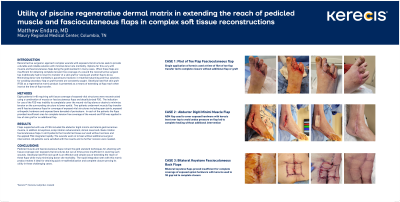Case Series/Study
(CS-054) Utility of piscine regenerative dermal matrix in extending the reach of pedicled muscle and fasciocutaneous flaps in complex soft tissue reconstructions

Reconstructive surgeons approach complex wounds with exposed vital structures seek to provide a durable and reliable solution with minimal donor site morbidity. Options for this vary with muscle and fasciocutaneous flaps being the gold standard in many cases. When these flaps are insufficient for obtaining complete tension free coverage of a wound the reconstructive surgeon has traditionally had to resort to transfer of a skin graft or raising yet another flap to do so. Minimizing donor site morbidity is paramount, however, in treatment planning and thus solutions for avoiding secondary flap or graft harvest are constantly sought. Decellularized fish skin graft (FSG) as a regenerative matrix product is presented as a means of extendingcd flap reach when inset at the time of flap transfer.
Methods:
Eight patients (n=8) requiring soft tissue coverage of exposed vital structures were reconstructed using a combination of muscle or fascioucutaneous flaps and decellularized FSG. The indication for use of the FSG was inability to completely cover the wound via flap alone or desire to minimize tension on the surrounding structure ie lower eyelid. Two patients underwent muscle flap transfer and 8 fasciocutaneous flaps for coverage of exposed vital structures including open joints, exposed orthopedic hardware and exposed bone denuded of periosteum. In each of the patients the flaps provided insufficient area for complete tension free coverage of the wound and FSG was applied in lieu of skin graft or an additional flap.
Results:
Flaps supported with use of FSG included the abductor digiti minimi and lateral gastrocnemius muscle, in addition to keystone, scalp rotation advancement, dorsal nasal and cheek rotation fasciocutaneous flaps. In all 8 patients the transferred tissue survived without necrosis and the applied FSG integrated rapidly. The wounds went on to heal without additional surgical intervention. All patients were satisfied with the results and no further revision were needed.
Discussion:
Pedicled muscle and fasciocutaneous flaps remain the gold standard techniques for attaining soft tissue coverage over exposed vital structures but can at times prove insufficient in covering such wounds. Decellularized Fish skin graft is an effective and simple way of extending the reach of these flaps while truly minimizing donor site morbidity. The rapid integration seen with this matrix product makes it ideal for attaining quick re-epithelialization and complete closure proving its utility in these challenging cases.
Trademarked Items: Kerecis
References:

.png)